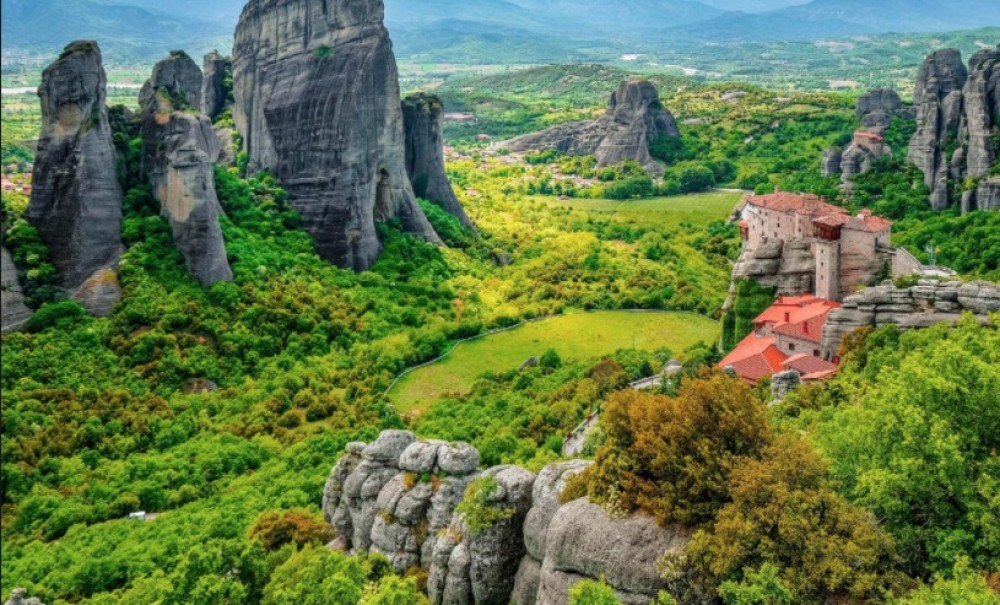Thessaly is a traditional geographic and modern administrative region of northern Greece. Before the Greek Dark Ages, Thessaly was known as Aeolia, and appears thus in Homer's Odyssey. The capital of the region is Larissa.
Most of the province has a hot summer Mediterranean climate, but also found is a cold semi-arid climate.
The alluvial soils of the Pineios Basin and its tributaries make Thessaly a vital agricultural area, particularly for the production of grain, cattle, and sheep.
In the last few decades, there has been a rise in the cultivation of dried nuts such as almonds, pistachios, and walnuts, especially in the region of Almyros.
From the foothills of Greece’s highest mountain, Olympus, across the vast plain of Larissa and down to the islands of the Sporades and the coast of Pilio, the region of Thessaly offers a smorgasbord of experiences and flavors.
Thessalian diet was organized based on the cycle of the seasons, the geographical location and the products available, the customs and the fasts, which were reverently kept by the inhabitants of the area. Another staple of the area was dairy products, and of course bread and their famous pies. Depending on the season, the filling of the pie changed, from trachanopita in winter to pumpkin pie in summer.
“Plastos” is also an old, traditional recipe with high nutritional value made mainly in Thessaly, Greece. It’s made with cornmeal, which abounds in the Thessalian Plain, greens, and, of course, with feta cheese, plenty of butter and olive oil. It’s an easy-to-make recipe, such as zucchini pie “Mpatzina”. “Mpatzina” was usually a summer recipe, also made during fall, while “Plastos” was made during fall, winter and spring, when there were plenty of greens.
Another popular recipe of the area is the traditional halva from the town of Farsala, made with semolina, sugar and almonds.
Join us in this journey around Thessalian cuisine!
Most of the province has a hot summer Mediterranean climate, but also found is a cold semi-arid climate.
The alluvial soils of the Pineios Basin and its tributaries make Thessaly a vital agricultural area, particularly for the production of grain, cattle, and sheep.
In the last few decades, there has been a rise in the cultivation of dried nuts such as almonds, pistachios, and walnuts, especially in the region of Almyros.
From the foothills of Greece’s highest mountain, Olympus, across the vast plain of Larissa and down to the islands of the Sporades and the coast of Pilio, the region of Thessaly offers a smorgasbord of experiences and flavors.
Thessalian diet was organized based on the cycle of the seasons, the geographical location and the products available, the customs and the fasts, which were reverently kept by the inhabitants of the area. Another staple of the area was dairy products, and of course bread and their famous pies. Depending on the season, the filling of the pie changed, from trachanopita in winter to pumpkin pie in summer.
“Plastos” is also an old, traditional recipe with high nutritional value made mainly in Thessaly, Greece. It’s made with cornmeal, which abounds in the Thessalian Plain, greens, and, of course, with feta cheese, plenty of butter and olive oil. It’s an easy-to-make recipe, such as zucchini pie “Mpatzina”. “Mpatzina” was usually a summer recipe, also made during fall, while “Plastos” was made during fall, winter and spring, when there were plenty of greens.
Another popular recipe of the area is the traditional halva from the town of Farsala, made with semolina, sugar and almonds.
Join us in this journey around Thessalian cuisine!
72 Posidonos Avenue
17562 Paleo Faliro
Athens / Greece
Tel.: +30 210 98 72 000
E-mail: info@poseidonhotel.com.gr
ΜΗΤΕ: 0261Κ013Α0051000
17562 Paleo Faliro
Athens / Greece
Tel.: +30 210 98 72 000
E-mail: info@poseidonhotel.com.gr
ΜΗΤΕ: 0261Κ013Α0051000












